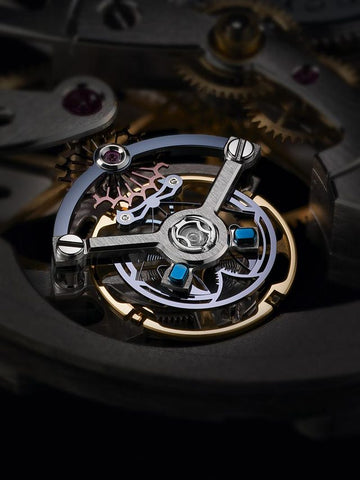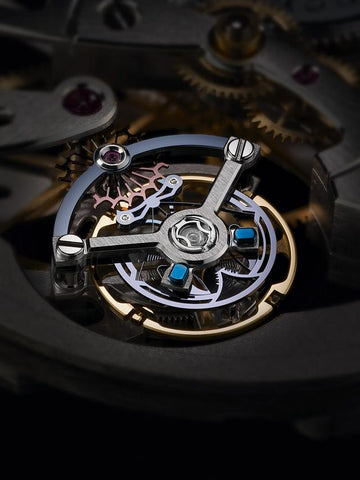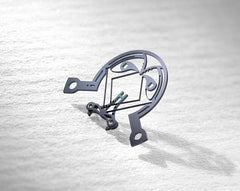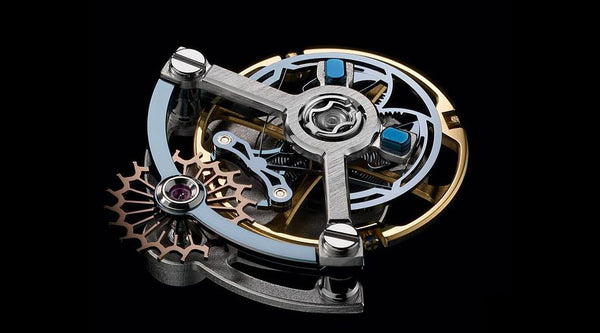Basel 2014 - New Ulysse Nardin Escapement

Mechanical Sophistication "Ulysse Anchor Escapement"
With seven years of research, development and improvements Ulysse Nardin is now in a position to present what appears to be a paradigm change in the approach to mechanical watchmaking. Overturning the traditional principle of the Swiss lever escapement, the new Ulysse Anchor Escapement features a circular silicon frame in which the pallet arms are suspended by two buckled blades (meaning curved under tension- one perpendicular to the other). This complex device relies on the physical property of blade springs to bend along one axis while remaining perfectly rigid along others, so as to reproduce the kinetics functions of a pivot.
The impulse, given at each semi-oscillation of the balance, transmits its energy to blades, which snap from one stable state to another, very much like a snap hair clip. The pallet arms, without a pallet staff, thus pivot from side to side without generating friction. Better still, when it returns to its original positions, the system gives back its stored energy with virtually no loss. Finally, the construction, which dispenses with the bridge for the pallet lever since it no longer pivots on a shaft, results in a slimmer movement.
This sophisticated mechanism, which comes into operation this year, opens new and unexplored opportunities for Ulysse Nardin.
Mechanical Sophistication "Ulysse Anchor Escapement"
At Ulysse Nardin, innovation is not only the price of independence, it's the very reason for the brands existence. The Le Locle manufacturing company, which has been at the forefront of research and development since it was founded in 1846, has not only made its mark on its own history, but on that of mechanical watchmaking as a whole. The new Ulysse Anchor Escapement reveals a hitherto unknown construction that tests the physical limits of materials. The silicon device, based on the principle of flexible materials, uses the elasticity of blade springs to dispense with the pivot of the pallet arms leaving them literally suspended in space. It's truly revolutionary.
 Ulysse Nardin's timeline is punctuated by inventions and world firsts. As early as 1862, the company's founder secured the Holy Grail at the London Universal Exhibition - the Prize Medal in the complicated watch category. The award not only attested to the excellence of its marine and pocket chronometers, it also heralded the pioneering spirit of the brand in the 21st century: the first to develop a silicon escapement in 2001; the first to produce a diamond balance spring in 2002, and in 2005, the first to offer an escapement without the traditional pallets and pallet wheel. Instead the Dual Ulysse in silicon has two impulse wheels. The same year Ulysse Nardin presented the first watch with a diamond escapement and, one year later, the first Diamond Coated Silicon (DiamonSil) escapement. Here again, Ulysse Nardin was the first to use silicon as a matrix on which to grow diamond crystal.
Ulysse Nardin's timeline is punctuated by inventions and world firsts. As early as 1862, the company's founder secured the Holy Grail at the London Universal Exhibition - the Prize Medal in the complicated watch category. The award not only attested to the excellence of its marine and pocket chronometers, it also heralded the pioneering spirit of the brand in the 21st century: the first to develop a silicon escapement in 2001; the first to produce a diamond balance spring in 2002, and in 2005, the first to offer an escapement without the traditional pallets and pallet wheel. Instead the Dual Ulysse in silicon has two impulse wheels. The same year Ulysse Nardin presented the first watch with a diamond escapement and, one year later, the first Diamond Coated Silicon (DiamonSil) escapement. Here again, Ulysse Nardin was the first to use silicon as a matrix on which to grow diamond crystal.
After seven years of research, development and improvements with Sigatec, a co-owned company specialized in silicon micro-components, Ulysse Nardin is now in a position to present what appears to be a paradigm change in the approach to mechanical watchmaking. Overturning the traditional principle of the Swiss lever escapement, the new Ulysse Anchor  Escapement features a circular silicon frame in which the pallet arms are suspended by two buckled blades (meaning curved under tension- one perpendicular to the other). This complex device relies on the physical property of blade springs to bend along one axis while remaining perfectly rigid along others, so as to reproduce the kinetics functions of a pivot.
Escapement features a circular silicon frame in which the pallet arms are suspended by two buckled blades (meaning curved under tension- one perpendicular to the other). This complex device relies on the physical property of blade springs to bend along one axis while remaining perfectly rigid along others, so as to reproduce the kinetics functions of a pivot.
The impulse, given at each semi-oscillation of the balance, transmits its energy to blades, which snap from one stable state to another, very much like a snap hair clip. The pallet arms, without a pallet staff, thus pivot from side to side without generating friction. Better still, when it returns to its original positions, the system gives back its stored energy with virtually no loss. Finally, the construction, which dispenses with the bridge for the pallet lever since it no longer pivots on a shaft, results in a slimmer movement.
This sophisticated mechanism, which should come into operation this year, opens new and unexplored opportunities for Ulysse Nardin.



